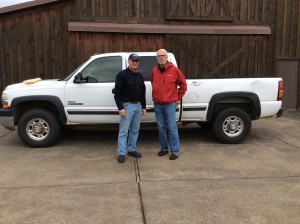“I though you said you were getting this property as a kind of Nature Conservancy thing, I mean, back at the beginning, and now it seems to be all about the wells, the road. . .”
“Yeah, I know. We’re going to . . .”
“The power saw? Cows? Sheep? Doesn’t sound all that environmental.”
“No, listen. The enviro folks at the beginning said we should own it for a year before. . .”
“The truck? Seriously?”
Oh, the truck! Bob. Here’s a photo with it’s former owner and new owner. The truck has 170 thousand plus miles on it, which is about the same mileage on Larry, so it’s a great fit.
Now, may I tell you about the well situation first? Then we’ll get to the environmental news, which is really cool. So. Remember that Well #2 came up pure salt water and we were going to test the water from Well #1? We finally got the lab report. We’ve celebrated too early before, but it does look as if this one will do the job. We’re staying calm.
Anyway, I called The NRCS agent, Samantha Bartling, for help on the subject of the environment, and got the name of a wildlife biologist, Steve Smith. He’s retired after 30 years with ODFW and USFWS, and now helps property owners create strategies for reclamation, restoration. Steve met with us last Thursday, and will provide us with an outline of what we can do, and what agencies can help.
We walked the property with him, and we felt that we’d been given new eyes. Seeing what we already had seen, but not. If that makes sense. So he bends down, brushes aside the fallen oak leaves and there is the tiniest sprout of something. Fawn lilies, he exclaims. And here’s ranunculus! And a lot of other somethings whose names I have already forgotten. In another month, he says, this will be a field of blue.
Don’t like the blackberries? Oh, you can form a partnership with ODFW. They have the equipment and the manpower to come onto the property and uproot the vines. Just call them.
Steve’s wife is a botanist, and would like to come out and help inventory the native plants, he says. We can get a bird inventory. There are salmon, chub, trout, in Muddy Creek, and turtles, and frogs. Oh, and by the way, what, he asks, is behind that gate along the eastern boundary?
He thinks that property is ours, too, that what we think is actual Muddy Creek is just a spur, that creek proper is well to the east. There was a NRCS survey a few years ago that should tell us. Well. We’ll see about this one. It’s not like I can tell what a hundred acres should feel like, and oops, we’re a little short.
It’s exciting! Not everyone, of course, has dirt under their fingernails (apparently it’s okay now to use “their” as a non-gender specific singular personal adjectival pronoun, in case you’re concerned). Last week, I took a friend with me to see my farm, and was glad to hear her say that she liked the smell of a barn, even one recently occupied by sheep, that she didn’t mind mud, that our oak trees are indeed beautiful. I hope that one day, every visitor may feel the same way.
That’s the goal. In the meanwhile, it’s back to planting those fruit trees. Next week’s goal. Steve gently suggested that tree planting is a young man’s game, and Larry might do well to rent an augur for the project. Sweet!


There’s Bob! Now that’s a “man’s truck!”